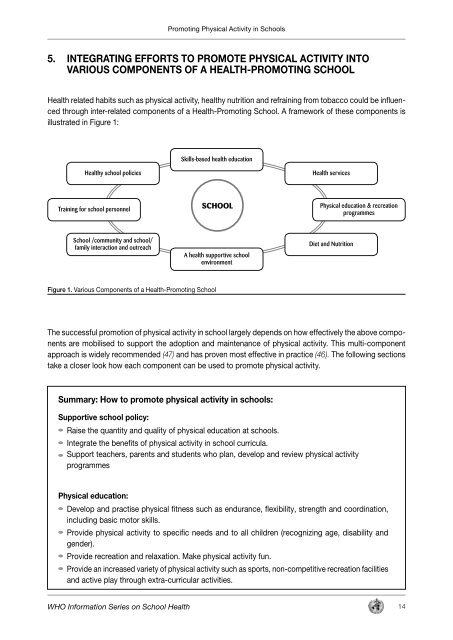WHO INFORMATION SERIES ON SCHOOL HEALTH ... - PAHO/WHO
WHO INFORMATION SERIES ON SCHOOL HEALTH ... - PAHO/WHO
WHO INFORMATION SERIES ON SCHOOL HEALTH ... - PAHO/WHO
You also want an ePaper? Increase the reach of your titles
YUMPU automatically turns print PDFs into web optimized ePapers that Google loves.
Promoting Physical Activity in Schools<br />
5. INTEGRATING EFFORTS TO PROMOTE PHYSICAL ACTIVITY INTO<br />
VARIOUS COMP<strong>ON</strong>ENTS OF A <strong>HEALTH</strong>-PROMOTING <strong>SCHOOL</strong><br />
Health related habits such as physical activity, healthy nutrition and refraining from tobacco could be influenced<br />
through inter-related components of a Health-Promoting School. A framework of these components is<br />
illustrated in Figure 1:<br />
Healthy school policies<br />
Training for school personnel<br />
School /community and school/<br />
family interaction and outreach<br />
The successful promotion of physical activity in school largely depends on how effectively the above components<br />
are mobilised to support the adoption and maintenance of physical activity. This multi-component<br />
approach is widely recommended (47) and has proven most effective in practice (46). The following sections<br />
take a closer look how each component can be used to promote physical activity.<br />
Summary: How to promote physical activity in schools:<br />
Supportive school policy:<br />
Raise the quantity and quality of physical education at schools.<br />
Integrate the benefits of physical activity in school curricula.<br />
Support teachers, parents and students who plan, develop and review physical activity<br />
programmes<br />
Physical education:<br />
Skills-based health education<br />
<strong>SCHOOL</strong><br />
A health supportive school<br />
environment<br />
Figure 1. Various Components of a Health-Promoting School<br />
Develop and practise physical fitness such as endurance, flexibility, strength and coordination,<br />
including basic motor skills.<br />
Provide physical activity to specific needs and to all children (recognizing age, disability and<br />
gender).<br />
Provide recreation and relaxation. Make physical activity fun.<br />
Health services<br />
Physical education & recreation<br />
programmes<br />
Diet and Nutrition<br />
Provide an increased variety of physical activity such as sports, non-competitive recreation facilities<br />
and active play through extra-curricular activities.<br />
<strong>WHO</strong> Information Series on School Health 14

















